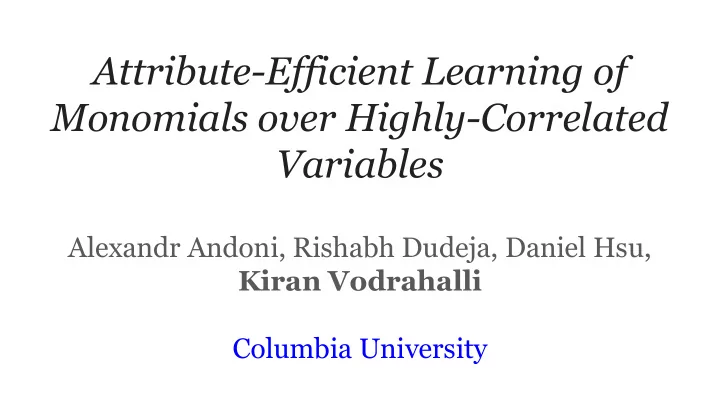

Attribute-Efficient Learning of Monomials over Highly-Correlated Variables Alexandr Andoni, Rishabh Dudeja, Daniel Hsu, Kiran Vodrahalli Columbia University
Problem Statement
Prior work: Attribute-efficient learning of polynomials Boolean domain Real domain - Learning sparse parities is a hard problem! - Sparse linear regression: attribute-efficient - RIP, REC, NSP assumptions on data Parity ⇔ monomial over {-1, +1} p - [Candes ‘04, Donoho ‘04, Bickel ‘09, …] - Many papers: [Helmbold et. al. ‘92, Blum ‘98, Klivans - General polynomials (NOT attribute-efficient ) & Servedio ‘06, Kalai et. al. ‘09, Kocaoglu et. al ‘14, ... ] - Sparse polynomials [Andoni et. al. ‘14] - Most results: - product distribution - Assume product distribution (often - Gaussian or uniform data uniform) - Runtime & sample complexity: Runtime ~ dimension c * sparsity , c < 1 - poly(dimension, 2 degree , sparsity) - NOT attribute-efficient Compare to naive dimension degree - Takeaway: Boolean setting Takeaway: Most work linear, rest well-studied and difficult! assumes product distribution.
This work: Non-product distributions for monomials ● One weird trick: Take the log of features and responses, run Lasso! ⇒ Attribute-efficient algorithm! ○ Learns k-sparse monomials ● ● Gaussian data ● Variance 1, covariance at most 1 - ε ○ Arbitrarily high correlation between features! Runtime: poly(samples, dimension, sparsity) ● Sample complexity: ~ ●
Binary Data Setting (reference for details) ● Boolean features ( Valiant ‘84, Littlestone ‘88, Helmbold et. al. ‘92, Klivans et. al. ‘06, Valiant ‘15 ): Conjunctions over {0, 1} p are learnable efficiently ○ Monomials over {+1, -1} p are parity functions and are PAC learnable ○ k-sparse parities: Sample efficient ( ), computationally inefficient ( ) ○ ■ Runtime improvement over naive case: Improper learner: samples, runtime ■ ○ Attribute-inefficient noisy parity: time for data under uniform dist. is noise parameter ■ ● Average case analysis for learning parity ( Kalai et. al. ‘09, Kocauglu et. al. ‘14 ): Learn DNF/ functions defined on {+1, -1} p ○ Can learn over adversarial + perturbed product distribution ○ ○ Can learn in smoothed analysis settings (adversarial + perturbed function)
Recommend
More recommend